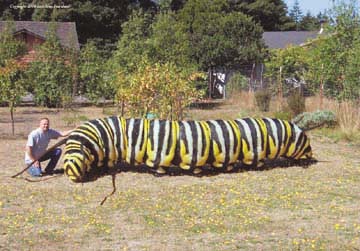|
Oct. 14, 2004
Eric Fidjeland's caterpillarsby AMY STEWART I MET ERIC FIDJELAND AT ARTS
ARCATA LAST MONTH. He had a terrific exhibit of his watercolors
at the Raymond James office -- mostly still lifes and landscapes,
all imbued with a sense of intimacy and familiarity, which is
not surprising considering that he was born, raised and educated
in Humboldt County. But I'll leave the discussion of his work
to the art critics. What captivated me most were the enormous
bunches of dahlias perched alongside the art. "Oh, those are mine," Eric said. "I'm just starting to paint from my garden." We stood chatting for a while about dahlias and how the weather had been this season and what else he had growing in his garden, when he said, "You might be interested in the milkweed. I've got caterpillars all over it this year." That's monarch butterfly caterpillars, folks. Within a week, I was over at his house, inspecting his milkweed setup. [Photo composite of a caterpillar. Copyright 2004 Eric Alan Fidjeland] If you ever visit the eucalyptus grove at Natural Bridges in Santa Cruz where monarchs like to stop during their migration to Mexico, you will find a very unattractive fenced pen labeled "Milkweed Garden." There are a few weedy plants inside being munched by caterpillars. The whole thing is not very garden-like and it turned me off milkweed for several years. But the idea of growing a monarch host plant is so appealing. Milkweed is the favorite food of the caterpillar, so adult monarchs skip through gardens and fields in search of it, and deposit their eggs there, knowing that when the eggs hatch, there will be a ready food source. Consumption of the plant's milky sap makes the caterpillars unpalatable to birds, which helps further ensure their survival. And now that milkweed is growing in popularity, there are far more ornamental varieties available than ever before. The red-flowering varieties like Asclepias curassavica are so beautiful that I even saw them recently in mixed bouquets of fall flowers in Amsterdam. There's also a gorgeous yellow A. tuberosa, and there are some pink and purple varieties available like A. purpurascens and A. cordifolia. It's also worth looking out for the many native California varieties, including the showy milkweed A. speciosa, with its pinkish-white flowers, and the yellowish Indian milkweed, A. eriocarpa. You can find them at nurseries around town, at the farmers' markets, or online from nurseries like www.laspilitas.com or www.milkweedfarm.com. Eric mostly grows the red-flowering varieties in a long, sweeping perennial border around his home in Eureka. He mixes them in with salvia, verbena, sunflowers and dahlias The monarchs don't seem to have any trouble finding them in this mixed border. I saw four or five caterpillars on every plant, and these were young, 1-year-old plants that were barely 2- or 3-feet high. I can only imagine how many baby monarchs will be feeding on them in a year or two, when they reach 3 or 4 feet tall. Because Eric's home is surrounded by plenty of trees and open space, he hopes to establish a haven for monarchs by providing a rich food and nectar source in an already butterfly-friendly area. He worries about the fate of each caterpillar -- once you watch the brightly striped creatures crawling up and down the narrow leaves of the milkweed plants, it is hard not to grow attached to them. He thinks that some of them have been attacked by parasitic wasps that lay their eggs in the caterpillars and eat them from the inside out. So he's carefully picked some of the caterpillars off the plants and moved them to a glass and wire mesh cage, where they feed on milkweed cuttings and move quickly into their pupal stage. "Even the pupa are beautiful," he told me, "like jade, almost, with that pale translucent green color and tiny gold flecks." The pupa hang from a branch inside the cage and he checks them every day, waiting for young butterflies to emerge. He's just begun some watercolors of the butterflies; if you'd like to see more of his work, check out www.ericfidjeland.com. Meanwhile, he offered the accompanying photo to the Journal as a way of expressing his extraordinary -- and oversized -- affection for the monarch caterpillars he's raising.
garden-related announcements and news to Amy Stewart. IN THE NEWS | COVER STORY | ART BEAT | THE HUM | PREVIEW | CALENDAR © Copyright 2004, North Coast Journal, Inc. |


